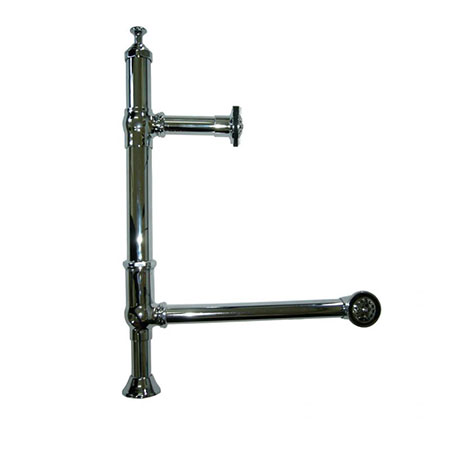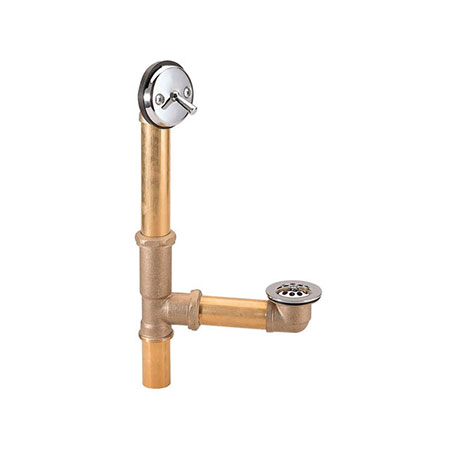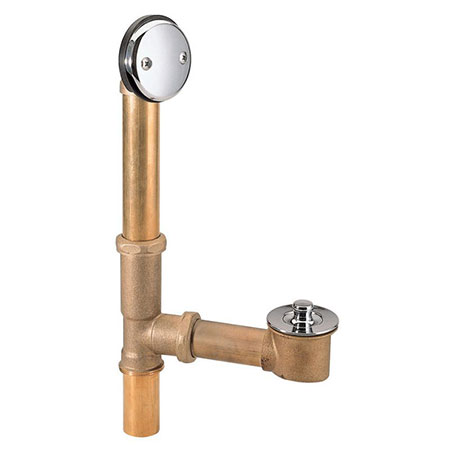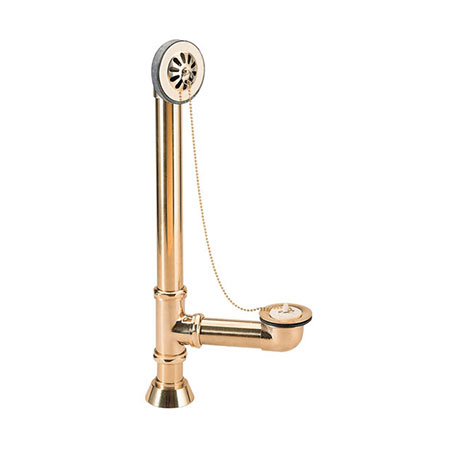Bathtub Drain: A Comprehensive Guide
A Bathtub Drain is a device that allows water to flow out of the tub after bathing. It consists of several components, such as the drain flange, the drain stopper, the overflow drain, and the drain pipe. A Bathtub Drain is not only a functional part of the bathroom, but also an aesthetic one, as it can enhance the appearance and style of the tub. In this guide, we will introduce you to the different types, materials, applications, history, and common questions of Bathtub Drains, as well as some tips on how to choose and maintain them.
A Bathtub Drain is a device that allows water to flow out of the tub after bathing. It consists of several components, such as the drain flange, the drain stopper, the overflow drain, and the drain pipe. A Bathtub Drain is not only a functional part of the bathroom, but also an aesthetic one, as it can enhance the appearance and style of the tub. In this guide, we will introduce you to the different types, materials, applications, history, and common questions of Bathtub Drains, as well as some tips on how to choose and maintain them.
Bathtub Drain
ZEN HAU INDUSTRY CO., LTD.
Learn everything you need to know about Bathtub Drains, from the different types and materials, to the various applications and history. Find the best Bathtub Drain manufacturer and suppliers for your bathroom project.
H-158
none
999999999
http://schema.org/InStock
USD
2020-12-31
https://www.bathroomdrainparts.com/waste-and-overflow.html
ZEN HAU INDUSTRY CO., LTD.
90out of
100based on
100user ratings
2 inch brass bathtub drain
H-158
Model :H-158
2 inch brass bathtub drain
Specification :1.0mmx2"x5"x10.5"x5"x5"x10" CP
Material :Brass,Rubber,Plastic.
Standing Waste
brass tube size
thickness = 1.0mm
Diameter = 2",
Length
5"
10+1/2"
5"
5"
10"
Color is CP.
Production method: Some parts are CNC turned, some are forged parts, some are cast parts, some are ceramic pieces and then assembled and sold in boxes.
ZEN HAU INDUSTRY CO., LTD.
Learn everything you need to know about Bathtub Drains, from the different types and materials, to the various applications and history. Find the best Bathtub Drain manufacturer and suppliers for your bathroom project.
H-134
none
999999999
http://schema.org/InStock
USD
2020-12-31
https://www.bathroomdrainparts.com/waste-and-overflow-kit.html
ZEN HAU INDUSTRY CO., LTD.
90out of
100based on
100user ratings
Hidden tub overflow
H-134
Model :H-134
Hidden tub overflow
Specification :0.6mmx1+1/2"x9+1/4"x4+1/4"x"x3" RB
Material :Brass,Rubber,Plastic.
Tub drain with overflow.
Color is RB.
Material: Brass (Brass is an alloy of copper and zinc, named for its yellow color. The melting point of brass is about 900 to 940 °C, depending on the composition. Brass has good mechanical properties and wear resistance, and can be used to manufacture precision instruments, ship parts, gun shells, coins, etc. Different zinc content will also have different colors. For example, if the zinc content is 18%-20%, it will appear reddish yellow, and if the zinc content is 20%-30%, it will appear brownish yellow. )
ZEN HAU INDUSTRY CO., LTD.
Learn everything you need to know about Bathtub Drains, from the different types and materials, to the various applications and history. Find the best Bathtub Drain manufacturer and suppliers for your bathroom project.
H-135
none
999999999
http://schema.org/InStock
USD
2020-12-31
https://www.bathroomdrainparts.com/tub-waste-and-overflow.html
ZEN HAU INDUSTRY CO., LTD.
90out of
100based on
100user ratings
Precut claw foot tub drain
H-135
Model :H-135
Precut claw foot tub drain
Specification :1.0mmx1+1/2"x19"x19"x6" RB
Material :Brass,Rubber,Plastic.
Hidden tub overflow.
Precut claw foot tub drain.
Application: For bathtub drainage.
Minimum order quantity: 500pcs
ZEN HAU INDUSTRY CO., LTD.
Learn everything you need to know about Bathtub Drains, from the different types and materials, to the various applications and history. Find the best Bathtub Drain manufacturer and suppliers for your bathroom project.
H-133
none
999999999
http://schema.org/InStock
USD
2020-12-31
https://www.bathroomdrainparts.com/tub-overflow-kit.html
ZEN HAU INDUSTRY CO., LTD.
90out of
100based on
100user ratings
trip lever waste and overflow.
H-133
Model :H-133
trip lever waste and overflow
Specification :1.0mmx1+1/2x19"x19"x6" PVD
Material :Brass,Rubber,Plastic.
Net Weight :1450g
.
Brass Contruction.
Tube Size: 1-1/2" OD Brass Tube.
Total Height= 27" Max.(cut short to fit).
Depth = 14" (cut short to fit).
Over Length Brass Tube 20 Guage.
Brass Pull Chain with Rubber Stopper.
Stain Nickel Finish.
Net Weight :1450g
Product Development Story: A company asked us to develop this product.
Place of Origin: Lukang, Changhua, Taiwan
1)Types of
There are many
Lift-and-turn drain: This type of drain has a knob on the top that can be lifted and turned to open or close the drain. It is easy to use and install, but it may get stuck if closed too tightly.
Push-and-pull drain: This type of drain has a knob on the top that can be pushed down or pulled up to open or close the drain. It is similar to the lift-and-turn drain, but it does not require twisting.
Toe-touch drain: This type of drain has a spring-loaded cap that can be pressed with the toe to open or close the drain. It is convenient and simple, but the spring may wear out over time.
Flip-it drain: This type of drain has a lever on the top that can be flipped from side to side to open or close the drain. It is easy to install and operate, but it may not seal well if the drain is not clean.
Trip-lever drain: This type of drain has a lever on the overflow plate that can be moved up or down to open or close the drain. It is durable and reliable, but it may be hard to access and clean.
Pop-up drain: This type of drain has a stopper that pops up or down when activated by a lever or a button. It is modern and sleek, but it may be prone to clogging and leaking.
2)Materials of
Metal: Metal drains are usually made of brass, copper, stainless steel, or chrome. They are strong, durable, and resistant to corrosion and rust. However, they are also more expensive, heavier, and harder to cut and fit.
Plastic: Plastic drains are usually made of PVC, ABS, or polypropylene. They are cheap, light, and easy to cut and fit. However, they are also less durable, more prone to cracking and warping, and less resistant to high temperatures and chemicals. Rubber: Rubber drains are usually made of silicone, neoprene, or latex. They are flexible, soft, and easy to seal and remove. However, they are also less durable, more prone to tearing and degrading, and less resistant to high temperatures and chemicals.
3)Applications of
Commercial:
Industrial:
4)History of
Ancient times: The earliest bathtubs were made of pottery, wood, or metal, and had simple holes or plugs for drainage. They were mainly used by the wealthy and powerful, such as the Egyptians, Greeks, and Romans, who valued bathing as a ritual and a luxury.
Middle Ages: The use of bathtubs declined during the Middle Ages, as bathing was considered a health risk and a sin by the church and society. Most people washed themselves with basins or buckets of water and drained them by throwing them out of the window or door.
Renaissance: The use of bathtubs revived during the Renaissance, as bathing was rediscovered as a source of pleasure and hygiene. The bathtubs were made of copper, zinc, or iron, and had simple valves or stoppers for drainage. They were mainly used by the nobility and the royalty, who enjoyed bathing in private or public baths. Industrial Revolution: The use of bathtubs spread during the industrial revolution, as plumbing and sanitation improved and became more accessible. The bathtubs were made of cast iron, steel, or porcelain, and had more sophisticated drains and faucets. They were mainly used by the middle and upper classes, who appreciated bathing as a necessity and a comfort.
Modern times: The use of bathtubs became universal during modern times, as technology and innovation advanced and diversified. The bathtubs were made of acrylic, fiberglass, or marble, and had various types and styles of drains and fixtures. They were used by people of all backgrounds and preferences, who enjoyed bathing as a personal and customizable experience.
5)Common Questions about
Here are some of the common questions that people may have about
1. How do I clean a
Conclusion
A
Bathtub Drain
sThere are many
Bathtub Drain
s, each with its mechanism and design. Some of the most common ones are:Lift-and-turn drain: This type of drain has a knob on the top that can be lifted and turned to open or close the drain. It is easy to use and install, but it may get stuck if closed too tightly.
Push-and-pull drain: This type of drain has a knob on the top that can be pushed down or pulled up to open or close the drain. It is similar to the lift-and-turn drain, but it does not require twisting.
Toe-touch drain: This type of drain has a spring-loaded cap that can be pressed with the toe to open or close the drain. It is convenient and simple, but the spring may wear out over time.
Flip-it drain: This type of drain has a lever on the top that can be flipped from side to side to open or close the drain. It is easy to install and operate, but it may not seal well if the drain is not clean.
Trip-lever drain: This type of drain has a lever on the overflow plate that can be moved up or down to open or close the drain. It is durable and reliable, but it may be hard to access and clean.
Pop-up drain: This type of drain has a stopper that pops up or down when activated by a lever or a button. It is modern and sleek, but it may be prone to clogging and leaking.
2)Materials of
Bathtub Drain
sBathtub Drain
s can be made of different materials, such as metal, plastic, or rubber. Each material has its advantages and disadvantages, such as:Metal: Metal drains are usually made of brass, copper, stainless steel, or chrome. They are strong, durable, and resistant to corrosion and rust. However, they are also more expensive, heavier, and harder to cut and fit.
Plastic: Plastic drains are usually made of PVC, ABS, or polypropylene. They are cheap, light, and easy to cut and fit. However, they are also less durable, more prone to cracking and warping, and less resistant to high temperatures and chemicals. Rubber: Rubber drains are usually made of silicone, neoprene, or latex. They are flexible, soft, and easy to seal and remove. However, they are also less durable, more prone to tearing and degrading, and less resistant to high temperatures and chemicals.
3)Applications of
Bathtub Drain
sBathtub Drain
s can be used for different purposes and in different settings, such as: Residential:Bathtub Drain
s are commonly used in residential bathrooms, where they provide drainage and comfort for the users. They can also add to the style and design of the bathroom, depending on the type and material of the drain.Commercial:
Bathtub Drain
s are also used in commercial settings, such as hotels, spas, gyms, or hospitals, providing drainage and hygiene for customers or patients. They can also enhance the image and reputation of the business, depending on the quality and performance of the drain.Industrial:
Bathtub Drain
s are sometimes used in industrial settings, such as factories, laboratories, or workshops, where they provide drainage and safety for the workers or equipment. Depending on the drain's material and durability, they can also prevent contamination and damage.4)History of
Bathtub Drain
sBathtub Drain
s have a long and interesting history, dating back to ancient times. Some of the milestones are:Ancient times: The earliest bathtubs were made of pottery, wood, or metal, and had simple holes or plugs for drainage. They were mainly used by the wealthy and powerful, such as the Egyptians, Greeks, and Romans, who valued bathing as a ritual and a luxury.
Middle Ages: The use of bathtubs declined during the Middle Ages, as bathing was considered a health risk and a sin by the church and society. Most people washed themselves with basins or buckets of water and drained them by throwing them out of the window or door.
Renaissance: The use of bathtubs revived during the Renaissance, as bathing was rediscovered as a source of pleasure and hygiene. The bathtubs were made of copper, zinc, or iron, and had simple valves or stoppers for drainage. They were mainly used by the nobility and the royalty, who enjoyed bathing in private or public baths. Industrial Revolution: The use of bathtubs spread during the industrial revolution, as plumbing and sanitation improved and became more accessible. The bathtubs were made of cast iron, steel, or porcelain, and had more sophisticated drains and faucets. They were mainly used by the middle and upper classes, who appreciated bathing as a necessity and a comfort.
Modern times: The use of bathtubs became universal during modern times, as technology and innovation advanced and diversified. The bathtubs were made of acrylic, fiberglass, or marble, and had various types and styles of drains and fixtures. They were used by people of all backgrounds and preferences, who enjoyed bathing as a personal and customizable experience.
5)Common Questions about
Bathtub Drain
sHere are some of the common questions that people may have about
Bathtub Drain
s, and the answers to them:1. How do I clean a
Bathtub Drain
? To clean aBathtub Drain
, you can use a plunger, a drain snake, a drain claw, or a chemical cleaner to remove any clogs or debris. You can also use baking soda, vinegar, or lemon juice to dissolve any grease or soap scum. You can also use a toothbrush, a cloth, or a sponge to scrub any dirt or stains. You should clean yourBathtub Drain
regularly to prevent any buildup or blockage. 2. How do I replace aBathtub Drain
? To replace aBathtub Drain
, you need to remove the old drain and install the new one. You may need a wrench, a screwdriver, a hacksaw, a pliers, or a pipe cutter to do this. You may also need a plumber’s putty, plumber’s tape, or silicone caulk to seal the drain. You should follow the instructions of the manufacturer or the plumber to ensure a proper and safe installation. 3. How do I choose aBathtub Drain
? To choose aBathtub Drain
, you need to consider several factors, such as the type, the material, the size, the style, the color, and the price of the drain. You should also consider the compatibility, the functionality, the durability, and the maintenance of the drain. You should choose aBathtub Drain
that suits your needs, preferences, and budget. You should also consult a professional or a reputable seller to get the best advice and service.Conclusion
A
 English
English Français
Français Deutsch
Deutsch Русский
Русский Português
Português Italiano
Italiano हिन्दी
हिन्दी Español
Español Nederlandse
Nederlandse العربية
العربية Tiếng Việt
Tiếng Việt ภาษาไทย
ภาษาไทย Bahasa Indonesia
Bahasa Indonesia বাঙ্গালী
বাঙ্গালী Türk
Türk


